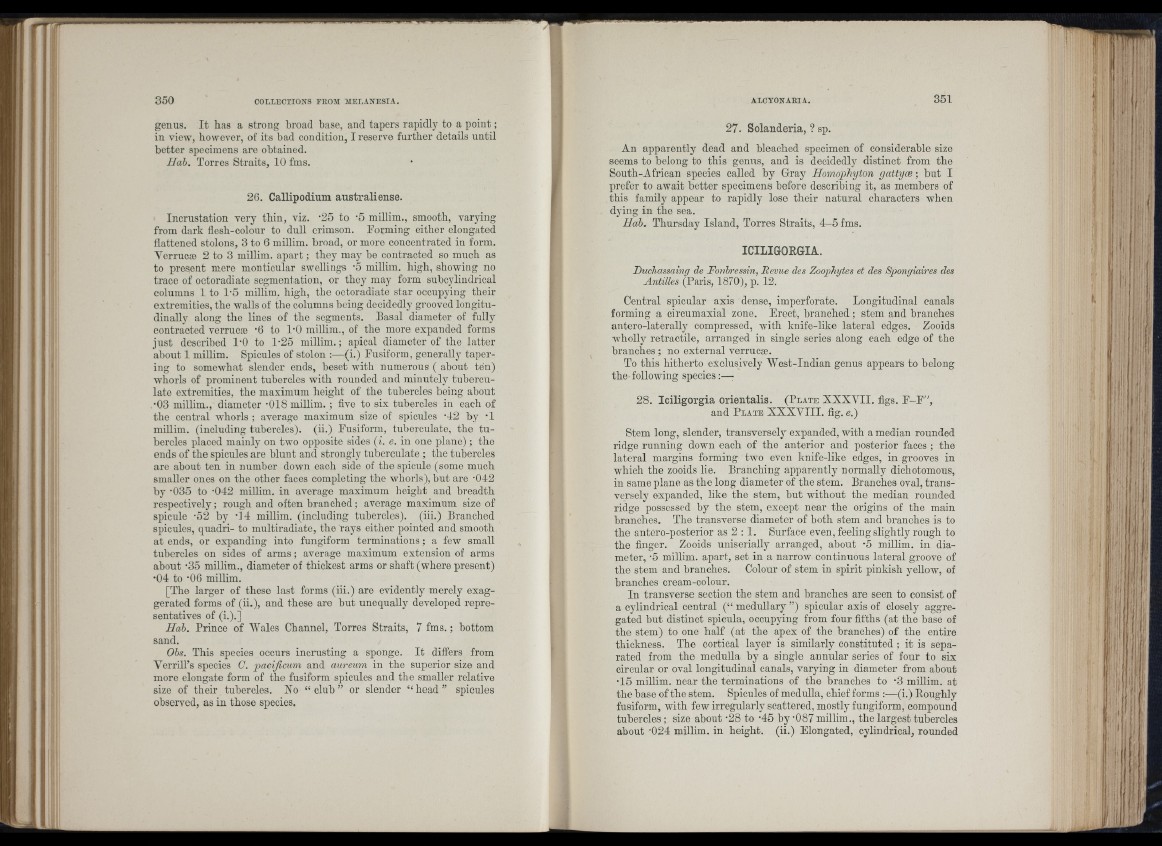
ïi'
il:,-
i| =
genus. I t has a strong broad base, and tapers rajiidly to a p o in t;
in view, however, of its bad condition, I reserve further details until
better specimens are obtained.
Hah. Torres Straits, 10 fms.
26. Callipodium australiense.
■ Incrustation very thin, viz. -25 to -5 millim., smooth, varjdng
from dark flesh-colonr to dull crimson. Eorming either elongated
flattened stolons, 3 to 6 millim. broad, or more concentrated in form.
Verrucæ 2 to 3 millim. apart ; they may be contracted so much as
to present mere monticular swellings '5 millim. high, showing no
trace of octoradiate segmentation, or they may form subcylindrical
columns 1 to 1'5 millim. high, the octoradiate star occupying their
extremities, the walls of the columns being decidedly grooved longitudinally
along the lines of the segments. Basal diameter of fully
contracted verrucæ '6 to I'O millim., of the more expanded forms
ju st described I ’O to 1-25 millim. ; axiical diameter of the latter
about 1 millim. Spicules of stolon :—(i.) Fusiform, generally tapering
to somewhat slender ends, beset with numerous ( about ten)
whorls of prominent tubercles with rounded and minutely tuhercu-
late extremities, the maximum height of the tubercles being about
•03 millim., diameter -018 millim. ; five to six tubercles in each of
the central whorls ; average maximum size of spicules '42 by •!
millim. (including tubercles), (ii.) Fusiform, tuberculate, the tu bercles
xdaced mainly on two opposite sides {i. e. in one plane) ; tho
ends of the spicules are blunt and strongly tuberculate ; the tubercles
are about ten in number down each side of the siiicnle (some much
smaller ones on the other faces completing the whorls), but are -042
by •OSS to -042 millim. in average maximum height and breadth
respectively ; rough and often branched ; average maximum size of
spicule -52 by ’14 millim. (including tubercles), (iii.) Branched
spicules, qiiadri- to multiradiate, the rays either pointed and smooth
at ends, or expanding into fungiform terminations ; a few small
tubercles on sides of arms ; average maximum extension of arms
about -35 millim., diameter of thickest arms or shaft (where present)
•04 to ‘06 miUim.
[The larger of these last forms (iii.) are evidently merely exaggerated
forms of (ii.), and those are hut unequally developed representatives
of (i.).]
Hah. Prince of AVales Channel, Torres Straits, 7 fms. ; bottom
sand.
Ohs. This species occurs incrusting a sponge. I t differs from
Verrill’s species 0. pacijicum and aureum in the superior size and
more elongate form of the fusiform spicules and the smaller relative
size of their tubercles. No “ club ” or slender “ head ” spicules
observed, as in those species.
27. Solanderia, ? sp.
An apparently dead and bleached specimen of considerable size
seems to belong to this genus, and is decidedly distinct from the
South-African species called by Gray Homophyton gattyce ; but I
prefer to await better specimens before describing it, as members of
this family appear to rapidly lose their natural characters when
dying in tho sea.
Hab. Thursday Island, Torres Straits, 4 -5 fms.
ICILIGORGIA.
DucTiassaing de Fonbt'essin, Revue des Zoophytes et des Spongiaires des
Antilles (Paris, 1870), p. 12.
Central spicular axis dense, imperforate. Longitudinal canals
forming a circumaxial zone. Erect, branched ; stem and branches
antero-laterally compressed, with knife-like lateral edges. Zooids
wholly retractile, arranged in single series along each edge of the
branches ; no external verrucæ.
To this hitherto exclusively AVest-Indian genus appears to belong
the following species :—:
28. Iciligorgia orientalis. ( P l a t e XXXAAI. figs. E -F ”,
and P l a t e X X X V III. fig. e.)
Stem long, slender, transversely expanded, with a median rounded
ridge running down each of the anterior and posterior faces ; the
lateral margins forming two even knife-like edges, in grooves in
which the zooids lie. Branching ax+arently normally dichotomous,
in same plane as the loug diameter of the stem. Branches oval, transversely
expanded, like the stem, but without the median rounded
ridge possessed by the stem, exceiit near the origins of the main
branches. The transverse diameter of both stem and branches is to
the antero-posterior as 2 ; 1. Surface even, feeling slightly rough to
the finger. Zooids uniserially arranged, about •fi millim. in diameter,
’5 millim. apart, set in a narrow continuous lateral groove of
the stem and branches. Colour of stem in spirit pinkish yellow, of
branches cream-colour.
In transverse section the stem and branches are seen to consist of
a cylindrical central (“ medullary ”) spicular axis of closely aggregated
but distinct spicula, occupying from four fifths (at the base of
the stem) to one half (at the apex of the branches) of the entire
thickness. The cortical layer is similarly constituted ; it is separated
from the medulla by a single annular series of four to six
circular or oval longitudinal canals, varying in diameter from about
•15 millim. near the terminations of the branches to -3 millim. at
the base of the stem. Spicules of medulla, chief forms :—(i.) Boughly
fusiform, with few irregularly scattered, mostly fungiform, compound
tubercles ; size about -28 to •dfi by •087 millim., the largest tubercles
about '024 millim. in height, (ii.) Elongated, cylindrical, rounded
■ I'i
Ml